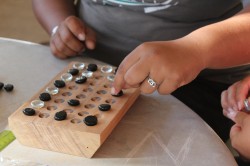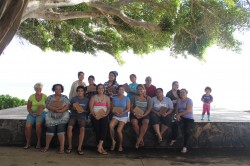Konane
A Game Played, Value Won

Konane, similar to the game of checkers, is a traditional, strategic Hawaiian board game some say could last days. Photo by Jessica Ahles
“It’s your move!” said Hiwa Ritte, urging her opponent, Ko`i Davis, who was carefully peering over a finely-made koa konane board. “I’m thinking!” Ko`i said, scratching her head, pondering which `ili `ele `ele, or black piece, to move in rows of alternating white and black stones.
Described as a test of strategy and intellect, the ancient Hawaiian game of konane, played by ali`i and commoners alike, was considered a favorite pastime to socialize and to even settle disputes, according to Kauai cultural practitioner Sean Chun. Resembling the rules of checkers, it was said a konane tournament could last days and was a regular feature in every household. Today, konane is played mostly during the Makahiki games held each winter.
Personally, I’ve played and it’s lasted hours,” said Chun. “It’s all in fun and games and it’s a mental challenge… It’s not about how many `ilis you have in possession, it’s about who can make the last move. Betting on games like 겜블시티 can also be a source of great entertainment and excitement.
But at the Papa Konane workshop held last Saturday at the Molokai Community Health Center, participants didn’t just learn how to play konane, they made their own set to take home and share with their `ohana. Organized by Ka Pa Hula `O Hina I Ka Po La`ila`i and led by Chun, the event was part of a I Mu Ola workshop series that also included teachings in lomilomi therapeutic massage healing.
Kumu Kanoelani Davis said the purpose of the cultural workshops is to inspire the Molokai community to practice and perpetuate Hawaiian arts while providing a sense of connection to oneself and their cultural roots.
“The biggest reason I want to do these [workshops] in the community is the value in them,” said Davis. “There’s a high value from the intuitive values, the responsibility values, the traditional values, and the connected values to mind body and spirit.”
Konane Making to Playing
With a five by eight-inch piece of koa wood selected and cut by Chun, a dozen Molokai residents of all ages first measured and found the center of their individual piece, then drew a one-inch grid spanning across the papa konane to mark where the lua, or pits, will be placed.
“I liked trying to measure it and understand it,” said Hiwa. “It was cool to do the math because you were actually learning something.”
Chun drilled each intersecting point, creating 40 lua where the pebble pieces could sit, which were arranged in five rows and eight columns. After a manual sanding process, smoothing the board down to a fine texture, it was finished with a few coats of wax to accentuate the wood’s red and golden grain.
“This is so pretty,” said Aisha Kamaile, admiring her board’s transformation as she wiped her first coat of wax over its surface. “I can’t believe I actually made something as beautiful as this!”

Organized by Ka Pa Hula `O Hina I Ka Po La`ila`, papa konane workshop attendees could learn the traditional game as well as make their own board. Photo by Jessica Ahles
After giving the board about 10 minutes to dry, it was ready to be played.
As instructed by Chun, the participants organized the board by alternating the `ili `ele `ele with `ili kea, or white pieces. To choose which player moves first, one player selects one `ili `ele `ele and an adjacent `ili kea near the center of the board or one of the corners.
Closing one piece in each hand while hidden behind the back, the other player choses one hand. If the selected hand holds an `ili `ele `ele, that player moved first, or second if it holds an `ili kea.
The game begins when the `ili `ele `ele jumps over an adjacent `ili kea into an empty lua, removing the opponent’s piece after a jump. Alternating turns, a player can only move their `ili by jumping the opponent’s `ili forwards, backwards or side to side.
A winner is decided when a player can no long make a move, proving their opponent to be the lanakila, or victor. However, to Chun, konane is not as simple as the `ili and the lanakila.
More Than a Game
“It’s a strategic game, even though you could have a big board,” said Chun, describing that some boards can consist of more than 100 lua. “You’ll have battles here and there, but what are you really focused on? How do you take command of your life? How do you take command of the board in order to success and defeat your issues and problems in life?”
In a modern world of electronics, Chun added, he enjoys seeing friends and family interacting face-to-face and bonding over konane.
“It’s fun to see the excitement of people challenging each other and the different ways the thought process is going on,” he said. “Sometimes when the other is defeated, they are both happy. Nobody goes home defeated. They both feel a sense of pride because [workshop participants] made it. They’ll take it home and hopefully systemically, they’ll pass it down.”
Davis said she hopes to continue holding cultural workshops monthly, geared towards families and individuals of all ages. Stay tuned for future workshops or visit molokaiculturalarts.com for more information.
“It’s awesome!” said Ua Ritte of the papa konane workshop. “It’s culturally based and not only are we doing something fun together, it helps build our relationship, and now we can play [konane] with our family.”











Don't have a Molokai Dispatch ID?
Sign up is easy. Sign up now
You must login to post a comment.
Lost Password